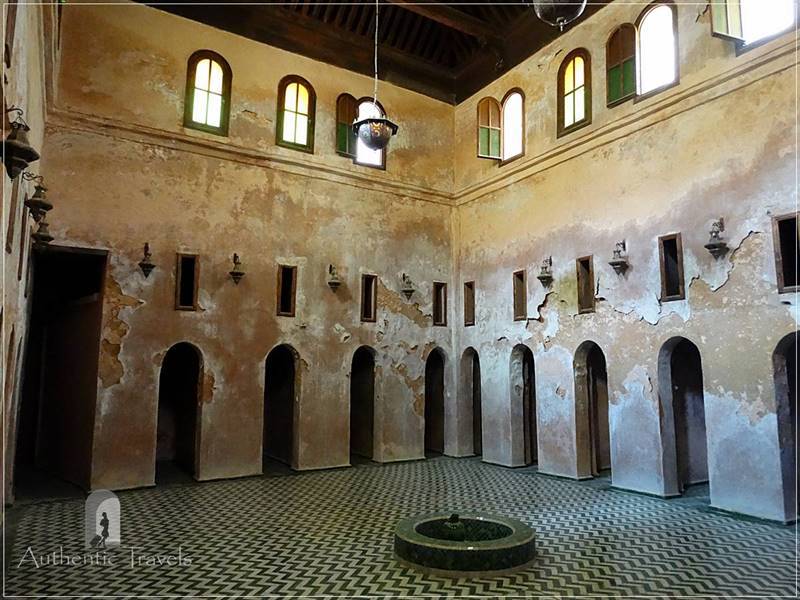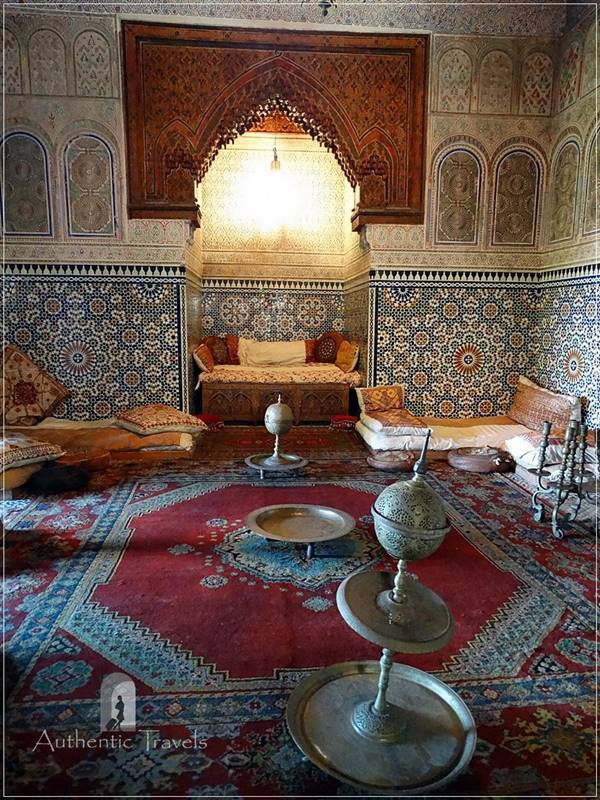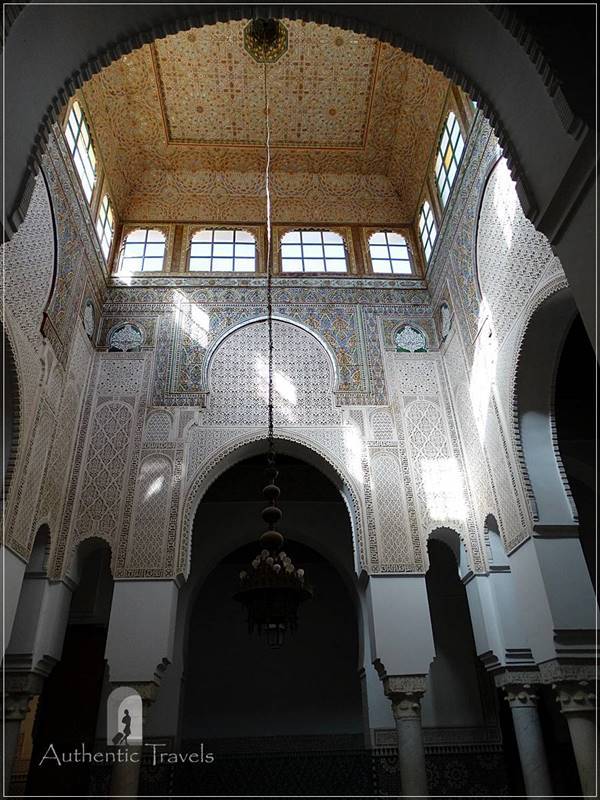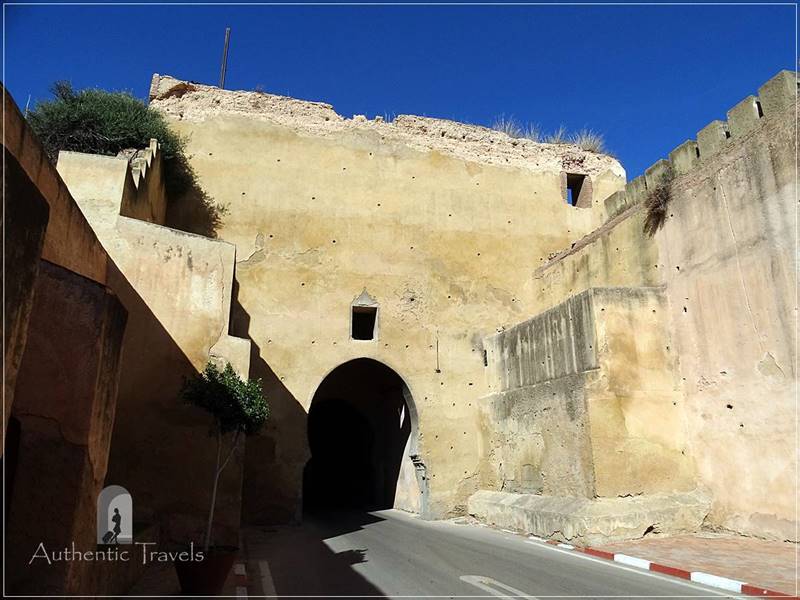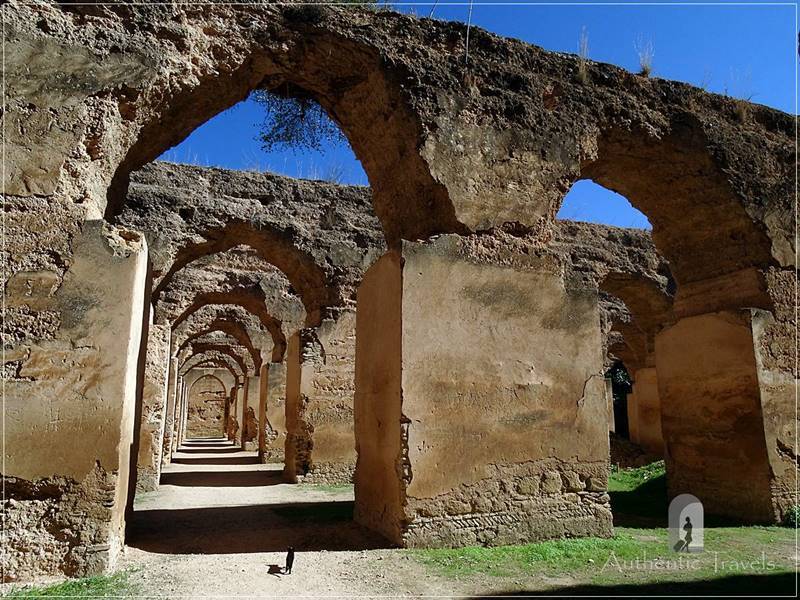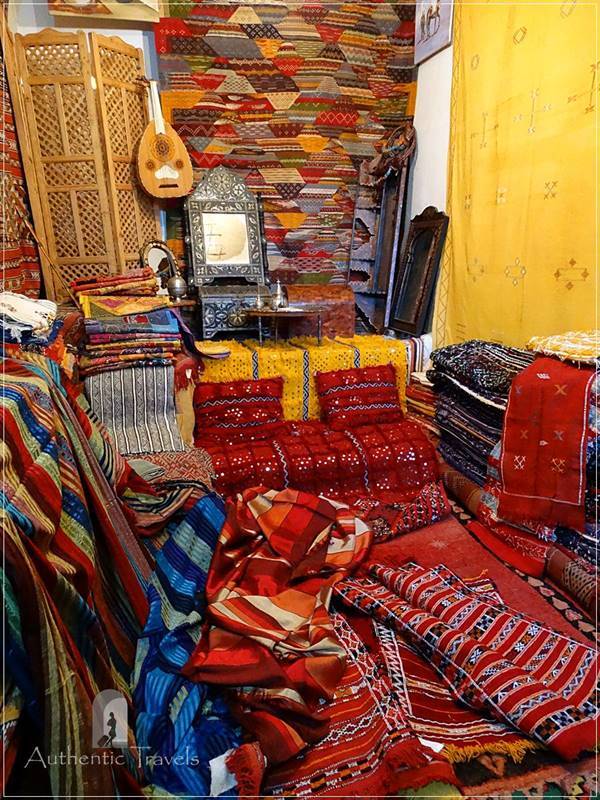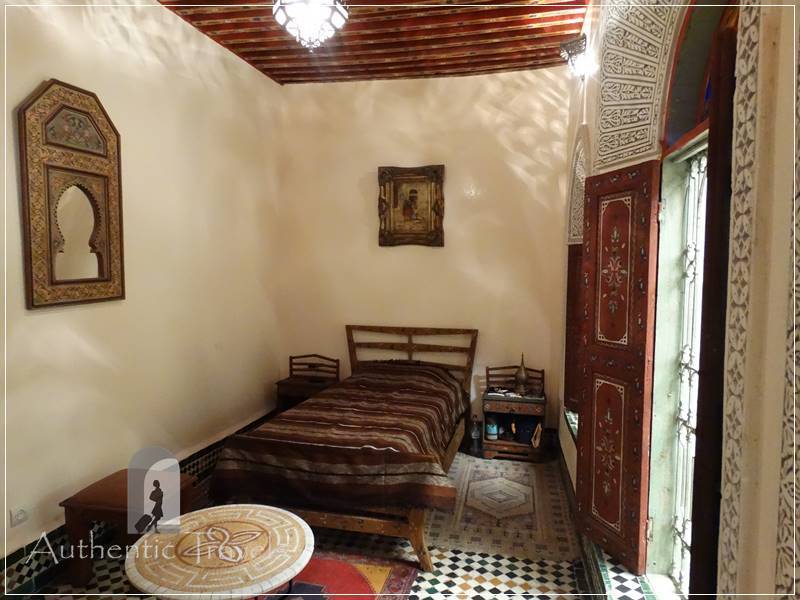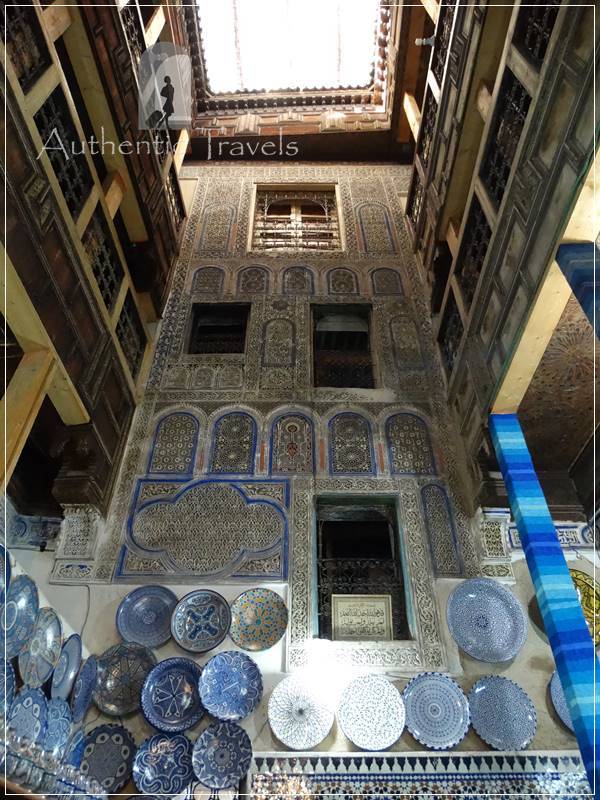The Imperial City of Meknes and the last days in Fes – Morocco
Meknes, the first day – the old medina
Short Description: I arrived in Meknes on the second part of the day and accommodated at Riad Ma Boheme. I strolled through the medina and went to El-Hedim Square (the central square) and Dar Jamai Palace.
Long Description.
After I settled in my accommodation at Riad Ma Boheme, I strolled on the streets in the medina of Meknes. Two men sewed traditional clothes in a small shop packed with kaftans. Medersa Bou Inania – a Koranic school like many others in Morocco, and a library were attached to the grand mosque. They were both built during the Merinids dynasty and featured a classic courtyard with a central marble fountain for ablutions, tiny mosaic floors with lots of green, stucco lace on the walls, and an abundance of inlays on the wooden cornice. The houses surrounding the beautiful medersa had unusable and insalubrious courtyards though, full of garbage and grass.
El-Hedim Square in Meknes was very similar to Djema el-Fna in Marrakech. Sedated snakes hissed on blankets placed in the square. Piles of ceramic and tajine pots flanked the sides of the square while beautifully adorned horses waited to be ridden in exchange for a picture. There was no shortage of Berber jewelry, European clothes, and heaps of plastic slippers.
In the central square, I sat down at a terrace to have lunch. While I was eating, I witnessed how restaurants got their food supplies. A van parked in front of the restaurant and started to unload several boxes with food. Then, a donkey head was dragged with a hook from the van’s floor. The head was then thrown into a cart and carried to the kitchen. I lost my appetite as I skeptically looked at the donkey head … with its sloping ears jerking in the cart pulled on the square’s cobblestones. I didn’t know what I had on my plate, but it tasted good …
Meknes was one of the four Imperial Cities of Morocco (listed as a UNESCO World Heritage Site). Moulay Ismail built many monuments in Meknes in his glory days. Dar Jamai stood on a secondary street near the central square. The palace initially belonged to the Moroccan Jamai family and later (after the death of the sultan) became the property of the Al Glaoui family.
Dar Jamai Palace had an Andalusian garden with palm trees and mandarins, where the zellij mosaic fountains hadn’t worked for a long time. However, the colorful mosaics enriched the space with colors and floral patterns. Even though it had no furnishings, the palace hosted a museum with a mix of mosaics, stuccoes, and wooden inlays. Doors featured decorative paintings, and the harem an exuberant richness. It displayed mosaics with floral patterns, red Berber carpets, stuccoes with carefully decorated niches, a discreet light through stained glass windows, low sofas with many pillows, and round supports for serving tea or dishes.
Next to the main square, a wing of the Royal Palace housed the Museum of Traditional Arts and Crafts. The museum had a small courtyard with a central fountain and several rooms precariously furnished with mannequins dressed in traditional costumes.
In the evening, I returned to Riad Ma Boheme where David tried to explain to his new guests what to see in Meknes. I told them I liked Dar Jamai. At that moment, David looked at me resentfully because he didn’t know about that place.
Meknes, the second day – the royal stables and granaries
Short Description: I headed to the Mausoleum of Moulay Ismail, then went along the fortification walls to the Royal Stables and Granaries – Heri es-Souani. In the afternoon, Mohammad took me to a carpet shop but, eventually, I bought a kilim from another shop.
Long Description.
On the following day in Meknes, I planned to visit the royal stables and granaries in the Imperial City. I exited the medina through Bab el-Mansour – the biggest gate of the Imperial City. I walked along the endless walls of the Royal Palace and stopped at the Mausoleum of Moulay Ismail (one of the few Muslim places where people of other religions could enter).
The Mausoleum of Moulay Ismail was located outside the medina, between the first and third fortification enclosure of the city. At the entrance, the guard Mohammad gave me all the necessary instructions to visit the place. I told him that my ICOMOS card wasn’t accepted at the Bou Inania Medersa on the previous day. He said that if I had gone to the Ministry of Tourism, they would have issued me a kind of press statement to enter for free all monuments and museums in Morocco. „You are in Africa”, he said. „People don’t have the same culture as in Europe.”
The mausoleum had several inner courtyards. The first courtyards were simple, austere, completely undecorated – just a colorful mosaic and a central fountain. Inside the tomb though, the rooms had exuberant decorations with various colorful, geometric patterns. There were also zellij mosaics, stucco panels, and white marble floors. The tomb of Sultan Moulay Ismail stood in the center of a room, but non-Muslims couldn’t enter there.
In the morning, David hadn’t wanted to tell me how much a Berber kilim cost. When I asked him where I could find one, he just sent me to a friend’s shop. Mohammad (the mausoleum guard) was very talkative though. When I asked him how much a small Berber kilim cost, he answered right away: ‘100-150 dirhams’. He told me that he knew a place where I could buy a kilim at that price. Everything seemed great. He would take me there after ending his shift. He didn’t look like a fake guide. And he wouldn’t have gotten a big commission from 150 dirhams. We agreed to go and see the carpets shop in the afternoon.
Moulay Ismail fortified the city with 25 kilometers of massive, endless, imposing, and insurmountable defense walls. Long walls started from the mausoleum and surrounded the vast royal estates. The fortifications then led to one of the largest structures ever built in Meknes – the royal stables and granaries, Heri es-Souani. The stables designed for 12,000 horses were one of the first projects of Sultan Moulay Ismail. Water channels spread under the floors to control the room temperature and air circulation. The huge, vaulted halls had been preserved pretty well, and you could enter from one room to another one.
The vaulted halls continued with massive walls outside in a large garden. Rhythmic, successive arches stood as proof of the real scale and complexity of a simple function – the royal stables. Even though vegetation overgrew in some areas, robust walls denoted the grandeur and magnificence of the construction techniques. When I wanted to leave, I accidentally met Mohammad (the guardian from the mausoleum), who led a group of tourists through the royal stables. He reminded me that after 2:00 p.m. he would be free to go to the kilim shop with me.
I had lunch until Mohammad ended his shift and visited another funerary monument in Koubbat as-Sufara (not very well preserved though). After that, I walked behind the mausoleum of Moulay Ismail in a neighborhood with labyrinthine streets and winding alleys.
I met Mohammad at the mausoleum at 2:00. He took me to the heart of the medina where he knew a big carpet shop refurbished in a two-story house with a patio. The vendors showed me dozens of carpets, small and large carpets, even though I told them I only wanted a small kilim. No, and no, and no. They wanted to show me everything they had. The prices for the carpets were very high compared to what Mohammad had told me.
When I told the vendor how much I could spend on a kilim (that was the price suggested by Mohammad), he laughed in contempt. He tried to drop the price, but everything was still around 1,000 dirhams, whereas I offered him only 150. I even explained that the guide told me about that price. The vendor called Mohammad and loathingly waved toward me and said something like: “Get her out of here. She’s not a good client! Why did you bring her here?!”
I was almost crying when we exited the carpet shop. Mohammad didn’t say anything. I didn’t know what to think about him. He suggested meeting again to drink and eat something in the new city in the evening, but he gave me clear instructions to not come with my phone or photo camera. I told him that I would come. But I just wanted to get rid of him, and I had no intention of meeting him again. Anyway, he had gossiped Amal and David of Riad Ma Boheme, and I didn’t like that at all.
I randomly strolled through the medina to get over my anger even though I was quite disappointed and always felt like crying. I entered a funduq, a carpenter’s shop, then I admired a tailor using an ingenious multi-threaded sewing machine system. Eventually, I ended up in Ahmed’s shop in a hidden corner of the medina.
In his shop, Ahmed had Berber rugs, Berber jewelry, all sorts of small wooden sculptures, and metal plates with intricate inlays. He told me a Berber kilim cost 200 dirhams, so I started to search for one to buy. I tried to negotiate it but he flatly refused me and said it was a student price, impossible to drop it more. I also would have liked to buy some Berber earrings, very beautiful, but they were very heavy. In the evening, David confirmed to me that I bought the kilim for the correct price.
The following day, I quickly reached Fes in about one hour of drive from Meknes and brought the car to the Hertz offices from where I had rented it five weeks before. After checking it, the lady from the office told me the car was dirty, so I offered to take and wash it somewhere. That day, however, it was a holiday for Muslims, so she nodded and accepted the car like that. After I left, she closed the office and hurried home to her family.
Traveling through Morocco without a personal car was challenging. I tried to find a taxi, but no one stopped. I could hardly drag the troller on the other side of the street and found a group that seemed to go to the medina with a shared taxi. We all crammed inside a small shared taxi, and I was the first to get off at Bab R’Cif.
At Bab R’Cif, I sat next to a gendarme and called Dar Moula to send someone to pick me up. The riad stood deeply hidden in the medina and I would have never found it by myself. An employee of the riad came and helped me with the luggage. When we arrived at the riad, he put me up in a luxurious room with original Berber decorations.
Everything was perfect at Dar Moula, just like in my dreams. Mosaics, carved and painted doors, inlaid ceiling, bed cover with Berber patterns, and a room overlooking the inner courtyard of the riad. In the morning, breakfast was served on the rooftop terrace, overlooking the entire medina – the largest medina in the world. For the first time in Morocco, I had fresh goat cheese and not melted cheese. The goat cheese, allegedly specific to Morocco, seemed, however, hard to find.
Fes, the last days in Morocco
I chose to spend the last days in Fes without any plan. I wanted to integrate everything I explored in Morocco. Walk at random on streets. Go shopping. And listen to the muezzin’s call to prayer (which I would miss a lot after six weeks in Morocco). Every night, I sat in the magnificent courtyard of the riad and selected pictures on my laptop while Moroccans wandering through the medina passed in front of the riad’s door.
I dedicated a whole day in Fes for shopping in the medina. In Souq Henna, I stopped at a pottery shop where I negotiated a plate, a mug, a glass, and a soap dish – all of them painted with the famous blue-of-Fes. Then I bought rose water and small perfume essence bottles from another stall. I even negotiated lunch on a rooftop terrace where they served me five small salads and roast chicken with little rice. For tourists, that menu would cost about 100 dirhams, but as I knew the prices in Morocco, they urgently dropped the price halfway.
On Talaa Sghira (one of the main streets in the medina), I went to the Blue House – a typical Moroccan house developed on several floors around an inner courtyard entirely decorated with blue ceramic plates (hence the name of the house). I negotiated a beautiful blue blanket with two small pillowcases for about an hour and a half. Mohamed (the salesman from the Blue House) had to ask for pillowcases at his neighbors because he didn’t have any. Part of the negotiation included going up onto the rooftop terrace from where you could see a complex of small tanneries, just perfect for photos without hordes of tourists.
On the last day in Morocco, my flight to Milan was in the afternoon. I spent the morning sunbathing on the terrace of Dar Moula. In the afternoon, the staff accompanied me to Bab R’Cif, where the owner had arranged a taxi to take me to the airport ($15 – as on my arrival, fair price).
At the airport, I did the mistake to write on the exit form that I had a travel blog. The woman at the counter didn’t want to let me pass to the transit zone. She thought I was a journalist who made money writing about Morocco. So she added my name next to the name of a hotel where she wanted to send me instead. I explained to her in my superficial French that I didn’t make money from travel writing. I told her I only had a blog where I wrote for free. The Moroccan behind me helped me with translation, and eventually, she miraculously let me pass.
In the airport transit area, I quickly wrote on the Facebook group of travel writers. Carlos (the director of Matador Travel Journalism School) immediately advised me to never do such a thing. Lesson learned. I would never declare again I was a travel writer. I could write a job name from my past and that was it.
We landed at Milan-Bergamo airport around midnight. There I had a stopover of about seven hours until morning. The administration of the airport didn’t allow us to walk throughout the airport at night. They forced layover-passengers to sleep on a narrow corridor where all the seats were occupied, and I could hardly find a place to sit down somewhere in a corner, on the floor. I managed to fall asleep a bit, and at 5:00 a.m., we woke up and finally could go to the check-in gates. I went straight to the boarding gate, and after six weeks of traveling through Morocco, I arrived home happy and fulfilled, with rich experiences.
If you want to read more about the road trip through Morocco, here are all the Travelogues from Morocco (x21).
Have you been to Morocco or plan to go there? Leave a comment below this post and tell me what you liked in Morocco or what you want to see there.
Want to subscribe to my travelogues? Just leave your email in the subscription form below, and you’ll be notified when I publish a new post.
